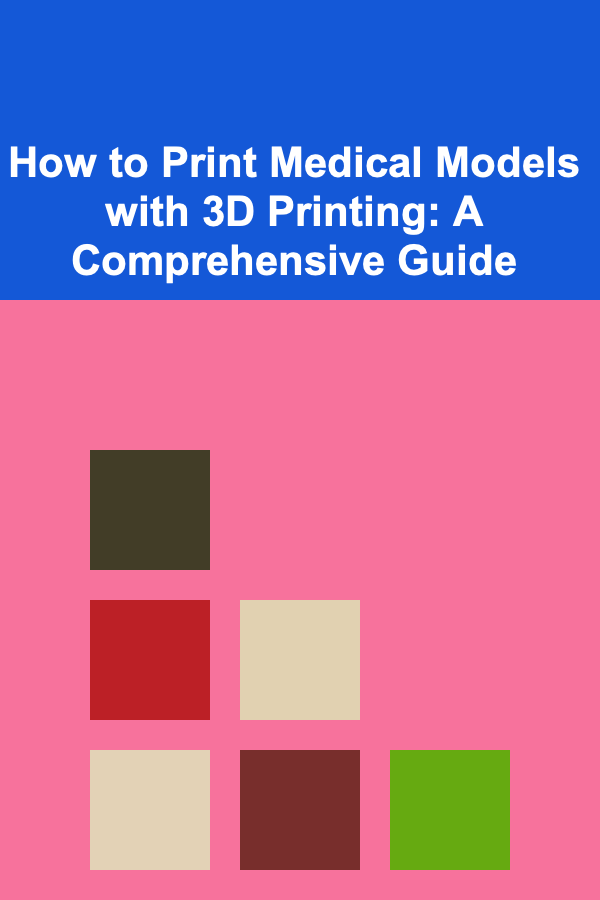
How to Print Medical Models with 3D Printing: A Comprehensive Guide
ebook include PDF & Audio bundle (Micro Guide)
$12.99$7.99
Limited Time Offer! Order within the next:

3D printing, also known as additive manufacturing, has revolutionized numerous industries, and the medical field is no exception. From surgical planning models to custom prosthetics and personalized implants, 3D printing offers unprecedented opportunities to enhance patient care, improve surgical outcomes, and drive innovation. This comprehensive guide provides a deep dive into the process of printing medical models using 3D printing technology, covering everything from data acquisition to post-processing.
I. Introduction to 3D Printing in Medicine
3D printing in medicine involves creating three-dimensional objects from digital designs using additive manufacturing processes. Unlike traditional subtractive manufacturing, where material is removed to create the final product, 3D printing builds objects layer by layer. This allows for the creation of complex geometries and customized designs, making it ideal for medical applications.
A. Benefits of 3D Printing in Healthcare
- Personalized Medicine: 3D printing enables the creation of patient-specific models and devices tailored to individual anatomy and needs.
- Improved Surgical Planning: Surgeons can use 3D printed models to visualize complex anatomy, practice surgical procedures, and plan for potential complications.
- Enhanced Medical Education: 3D printed anatomical models provide realistic and hands-on learning tools for medical students and residents.
- Custom Prosthetics and Implants: 3D printing facilitates the design and manufacture of custom prosthetics and implants that fit patients perfectly and improve their quality of life.
- Cost-Effectiveness: In certain applications, 3D printing can be more cost-effective than traditional manufacturing methods, especially for low-volume, customized parts.
- Accelerated Research and Development: 3D printing allows researchers to quickly prototype and test new medical devices and therapies.
B. Common Medical Applications of 3D Printing
The applications of 3D printing in medicine are rapidly expanding, but some of the most common include:
- Surgical Planning Models: Creating realistic models of bones, organs, and blood vessels to aid in surgical planning and training.
- Custom Prosthetics: Designing and manufacturing personalized prosthetics for patients with limb loss.
- Dental Implants and Orthodontics: Producing customized dental implants, crowns, bridges, and orthodontic aligners.
- Bioprinting: Printing living cells and tissues to create functional organs and tissues for transplantation and research. (This is a more advanced area, still largely in research.)
- Drug Delivery Devices: Creating customized drug delivery systems that release medication at specific rates and locations.
- Medical Devices: Manufacturing customized surgical tools, implants, and other medical devices.
II. The 3D Printing Workflow for Medical Models
The process of printing medical models involves several key steps, from data acquisition to post-processing. Each step is critical to ensuring the accuracy, functionality, and biocompatibility of the final product.
A. Data Acquisition: Medical Imaging
The first step in the 3D printing workflow is to acquire the necessary data to create a digital model of the anatomical structure of interest. This typically involves using medical imaging techniques such as:
- Computed Tomography (CT): CT scans use X-rays to create detailed cross-sectional images of the body. CT is excellent for imaging bone structures and dense tissues. It's the most common modality for generating models of the skeletal system.
- Magnetic Resonance Imaging (MRI): MRI uses magnetic fields and radio waves to create detailed images of soft tissues, such as organs, muscles, and ligaments. MRI excels at differentiating between different types of soft tissue and is preferred for imaging the brain, heart, and other soft organs.
- Ultrasound: Ultrasound uses sound waves to create images of soft tissues. It is often used for real-time imaging during surgical procedures. Its resolution is lower than CT or MRI, so it's less frequently used for creating detailed 3D models, but advancements are being made in 3D ultrasound reconstruction.
- 3D Surface Scanning: For external anatomical structures, such as faces or limbs, 3D surface scanners can be used to capture the shape and dimensions directly. This is particularly useful for prosthetics and orthotics applications.
The choice of imaging modality depends on the specific anatomical structure being modeled and the desired level of detail. It's important to note that patient radiation exposure is a consideration, particularly with CT scans. "As Low As Reasonably Achievable" (ALARA) principles should always be followed.
B. Image Segmentation and 3D Model Reconstruction
Once the medical images are acquired, they must be processed to extract the relevant anatomical information and create a 3D model. This process involves:
- Image Segmentation: Segmenting the images involves manually or automatically identifying and outlining the anatomical structure of interest in each image slice. This can be a time-consuming and labor-intensive process, but it is crucial for creating an accurate 3D model. Several software tools are available for image segmentation, including:
- Mimics Innovation Suite (Materialise): A widely used commercial software with advanced segmentation and 3D modeling capabilities.
- 3D Slicer: An open-source platform for medical image analysis and visualization, offering a wide range of segmentation tools.
- ITK-SNAP: An open-source software for segmenting 3D medical images.
- Horos: An open-source DICOM viewer and image processing tool based on OsiriX.
- SimpleITK: A simplified interface to the Insight Toolkit (ITK), offering a library of image analysis algorithms for segmentation and registration.
- 3D Model Reconstruction: After segmentation, the individual image slices are stacked together to create a 3D model. This model can then be refined and smoothed to improve its accuracy and visual appearance. Software will typically create a surface mesh representation (e.g., STL or OBJ file).
The accuracy of the segmentation process directly impacts the accuracy of the final 3D printed model. Therefore, it is essential to use appropriate segmentation techniques and software tools, and to carefully review and correct any errors.
C. Model Design and Optimization
After the 3D model has been reconstructed, it may need to be further designed and optimized for 3D printing. This can involve:
- Hollowing: Reducing the amount of material used by hollowing out the model. This saves on material costs and reduces printing time.
- Adding Support Structures: Designing support structures to prevent overhangs from collapsing during printing. These supports need to be carefully designed to minimize material usage and facilitate easy removal after printing.
- Adding Features: Incorporating features such as holes, channels, or textures to enhance the functionality or aesthetics of the model. For example, adding screw holes for implant fixation.
- Model Repair: Repairing any errors or imperfections in the model, such as gaps or self-intersections, that could cause problems during printing. Software like Meshmixer is particularly useful for this.
- Mesh Simplification: Reducing the number of triangles in the mesh to improve printing performance and reduce file size, while preserving the overall shape and details of the model.
The design and optimization process is crucial for ensuring that the 3D printed model is both accurate and printable. It requires a good understanding of 3D printing technology and design principles.
D. 3D Printing Technology Selection
Numerous 3D printing technologies are available, each with its own advantages and disadvantages. The choice of technology depends on the specific application, the desired material properties, and the required level of accuracy and detail. Some of the most commonly used 3D printing technologies for medical models include:
- Fused Deposition Modeling (FDM): FDM involves extruding a thermoplastic filament through a heated nozzle and depositing it layer by layer to build the model. FDM is relatively inexpensive and can be used with a variety of materials, including PLA, ABS, and PETG. It's commonly used for creating educational models and surgical guides.
- Stereolithography (SLA): SLA uses a laser to cure liquid resin layer by layer. SLA offers high accuracy and surface finish, making it suitable for creating detailed models and prototypes. Resins with biocompatible certifications are available.
- Selective Laser Sintering (SLS): SLS uses a laser to fuse powder particles together layer by layer. SLS can be used with a variety of materials, including nylon, and offers good mechanical properties. It's often used for creating functional prototypes and end-use parts.
- Multi Jet Fusion (MJF): MJF uses a fusing agent and thermal energy to selectively fuse powder particles together layer by layer. It's known for its high throughput and ability to produce parts with good mechanical properties and fine details. It's suitable for functional medical parts.
- PolyJet Printing: PolyJet printing jets liquid photopolymers onto a build platform and cures them with UV light. This technology allows for the creation of multi-material parts with varying colors and textures. It's useful for creating highly detailed and realistic anatomical models.
The selection of the appropriate 3D printing technology is a critical decision that can significantly impact the quality, cost, and turnaround time of the final product.
E. Material Selection
The material used for 3D printing medical models must be carefully selected to ensure biocompatibility, mechanical strength, and the desired aesthetic properties. Common materials include:
- PLA (Polylactic Acid): A biodegradable thermoplastic derived from renewable resources. PLA is easy to print and is suitable for creating educational models and prototypes.
- ABS (Acrylonitrile Butadiene Styrene): A strong and durable thermoplastic. ABS is suitable for creating functional parts and enclosures.
- PETG (Polyethylene Terephthalate Glycol-modified): A strong and chemical-resistant thermoplastic. PETG is often used for food-contact applications and medical devices.
- Nylon (Polyamide): A strong and flexible thermoplastic with good chemical resistance. Nylon is often used for creating functional prototypes and end-use parts.
- Resins: A variety of resins are available for SLA and PolyJet printing, including biocompatible and sterilizable options.
- Titanium: Used in metal 3D printing (e.g., Direct Metal Laser Sintering - DMLS) for implants due to its biocompatibility and strength.
- Stainless Steel: Another metal option for implants and instruments, offering strength and corrosion resistance.
When selecting a material for medical applications, it is essential to ensure that it is biocompatible and meets the necessary regulatory requirements. Materials with ISO 10993 certification are often preferred. The intended use case (e.g., external model vs. implantable device) significantly influences the required material properties and biocompatibility.
F. Print Preparation and Execution
Before printing, the 3D model must be prepared using slicing software. Slicing software converts the 3D model into a series of layers that the 3D printer can understand. This involves:
- Setting Print Parameters: Configuring parameters such as layer height, print speed, infill density, and support structure settings.
- Generating Support Structures: Automatically generating support structures to prevent overhangs from collapsing during printing.
- Generating Toolpaths: Creating the paths that the 3D printer will follow to deposit the material layer by layer.
Once the print job is prepared, it can be sent to the 3D printer for execution. The printing process can take anywhere from a few hours to several days, depending on the size and complexity of the model. It's important to monitor the printing process closely to ensure that everything is running smoothly and to address any issues that may arise.
G. Post-Processing
After the 3D printing process is complete, the model may require post-processing to remove support structures, smooth the surface, and enhance its appearance. Common post-processing techniques include:
- Support Removal: Carefully removing the support structures from the model using tools such as pliers, knives, or solvents.
- Surface Finishing: Smoothing the surface of the model using techniques such as sanding, polishing, or chemical vapor smoothing.
- Painting and Coating: Applying paint or coatings to enhance the appearance and durability of the model.
- Sterilization: Sterilizing the model using techniques such as autoclaving, ethylene oxide gas sterilization, or radiation sterilization, if the model will be used in a sterile environment.
Post-processing is an essential step in the 3D printing workflow, as it can significantly improve the quality and functionality of the final product. The choice of post-processing techniques depends on the material used and the intended application.
III. Software and Hardware Considerations
Successfully printing medical models requires the right software and hardware. This section outlines key considerations for both.
A. Software Selection
As mentioned previously, several software tools are critical for the 3D printing workflow:
- DICOM Viewers: Software for viewing and manipulating DICOM (Digital Imaging and Communications in Medicine) images. Examples include Horos and OsiriX.
- Segmentation Software: Software for segmenting medical images and creating 3D models. Examples include Mimics Innovation Suite, 3D Slicer, and ITK-SNAP.
- CAD Software: Software for designing and modifying 3D models. Examples include Fusion 360, SolidWorks, and Blender. Blender is open-source and useful for mesh manipulation.
- Slicing Software: Software for preparing 3D models for printing. Examples include Cura, Simplify3D, and PrusaSlicer.
The choice of software depends on the specific needs of the user and the complexity of the project. It's important to choose software that is compatible with the 3D printer being used and that offers the necessary features and functionality.
B. Hardware Selection
The choice of 3D printer depends on the specific application, the desired material properties, and the required level of accuracy and detail. Key considerations include:
- Printing Technology: FDM, SLA, SLS, MJF, and PolyJet each offer different advantages and disadvantages.
- Build Volume: The maximum size of the objects that can be printed.
- Resolution: The level of detail that the printer can achieve.
- Material Compatibility: The range of materials that the printer can print.
- Price: The cost of the printer and its consumables.
- Reliability and Maintenance: The ease of use and maintenance of the printer.
It's also crucial to consider environmental control if you're working with materials that are sensitive to temperature or humidity. Enclosed 3D printers or dedicated printing rooms may be necessary.
IV. Regulatory Considerations and Biocompatibility
The use of 3D printed medical models and devices is subject to strict regulatory requirements to ensure patient safety and efficacy. This section discusses the key regulatory considerations and the importance of biocompatibility.
A. Regulatory Frameworks
In the United States, the Food and Drug Administration (FDA) regulates the manufacturing and sale of medical devices, including those produced using 3D printing. The FDA has issued guidance on the use of 3D printing in medical device manufacturing, which outlines the requirements for design controls, material selection, and testing. Similar regulatory bodies exist in other countries, such as the European Medicines Agency (EMA) in Europe.
It's important to understand that the regulatory pathway for 3D printed medical devices depends on the intended use and the level of risk associated with the device. Devices that come into direct contact with patients or are implanted into the body are subject to more stringent regulatory requirements.
B. Biocompatibility Testing
Biocompatibility refers to the ability of a material to be in contact with the human body without causing adverse reactions. Medical devices that come into contact with patients or are implanted into the body must be biocompatible to ensure patient safety.
ISO 10993 is a series of international standards that outline the requirements for biocompatibility testing of medical devices. These standards cover a wide range of tests, including cytotoxicity, sensitization, irritation, and systemic toxicity.
The specific biocompatibility tests that are required depend on the intended use of the device and the duration of contact with the body. For example, a device that is implanted into the body for more than 30 days will require more extensive biocompatibility testing than a device that is only in contact with the skin for a few minutes.
C. Sterilization
Medical models that will come into contact with sterile environments (e.g., surgical field) must be sterilized to prevent infection. Common sterilization methods include:
- Autoclaving (Steam Sterilization): Using high-pressure steam to kill microorganisms. Not all 3D printing materials can withstand autoclaving.
- Ethylene Oxide (EtO) Gas Sterilization: Using EtO gas to sterilize devices. Requires proper ventilation and handling due to the toxicity of EtO.
- Gamma Irradiation: Using gamma radiation to sterilize devices.
- Electron Beam (E-beam) Sterilization: Using electron beams to sterilize devices.
- Chemical Sterilization: Using liquid chemical sterilants. This method is less common for complex 3D printed models due to the challenge of ensuring complete penetration.
The chosen sterilization method must be compatible with the 3D printing material. Some materials may degrade or deform under certain sterilization conditions.
V. Future Trends in 3D Printing for Medical Models
The field of 3D printing in medicine is rapidly evolving, and several exciting trends are emerging that promise to further revolutionize healthcare.
- Advanced Materials: The development of new biocompatible materials with enhanced mechanical properties and functionality. This includes materials with antimicrobial properties, drug-releasing capabilities, and the ability to promote tissue regeneration.
- Bioprinting: Printing living cells and tissues to create functional organs and tissues for transplantation and research. This is a highly promising area of research that could eventually lead to the creation of artificial organs for patients in need.
- Artificial Intelligence (AI) and Machine Learning (ML): The use of AI and ML to automate and improve the 3D printing workflow. This includes using AI to optimize segmentation, design, and printing parameters, as well as to predict the performance of 3D printed devices.
- Point-of-Care 3D Printing: The establishment of 3D printing facilities within hospitals and clinics to enable on-demand production of customized medical models and devices. This allows for faster turnaround times and greater control over the manufacturing process.
- Integration with Virtual and Augmented Reality: Combining 3D printed models with virtual and augmented reality technologies to enhance surgical planning and training. Surgeons can use VR and AR to interact with 3D printed models in a realistic and immersive environment.
VI. Conclusion
3D printing is transforming the medical field by enabling the creation of customized medical models, prosthetics, implants, and other devices. While the process involves careful consideration of data acquisition, software, hardware, materials, and regulatory requirements, the potential benefits for patient care and medical innovation are immense. As the technology continues to evolve, we can expect to see even more exciting applications of 3D printing in medicine in the years to come. Continuous learning and adaptation to new advancements will be crucial for those involved in this rapidly developing field.

How to Create an Efficient Workspace for Hobbies
Read More
How to Save Water: Essential Tips for Reducing Water Usage
Read More
How to Understand Real Estate Market Trends
Read More
Smart Strategies for Lowering Health Insurance Premiums and Cutting Costs
Read More
The Art and Practice of Forgiveness Meditation
Read More10 Tips for Tracking Side Hustle Income with a Spreadsheet
Read MoreOther Products

How to Create an Efficient Workspace for Hobbies
Read More
How to Save Water: Essential Tips for Reducing Water Usage
Read More
How to Understand Real Estate Market Trends
Read More
Smart Strategies for Lowering Health Insurance Premiums and Cutting Costs
Read More